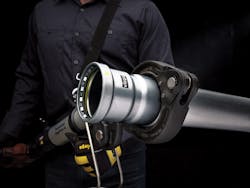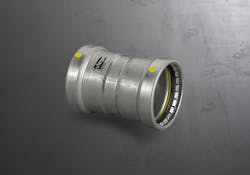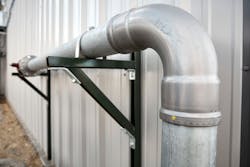Viega MegaPressG Pressing System Fills Market Niche
Pressing pipe has been gaining in popularity, largely due to its substantial advantages in installed cost, ease, speed, and safety over traditional methods of joining pipe. As the technology is adopted more widely, manufacturers continue to introduce press fittings for a variety of pipe materials, including copper, carbon steel, stainless steel, and PEX.
The number of approved applications also has increased to include water, compressed air, fuel oil, gas, and various chemicals. However, until this year, there was no pressing system approved for carbon steel gas and fuel oil pipe larger than 2 in.
Earlier this year, Viega LLC, the company which brought pressing technology to North America in 1999, solved that problem with three larger sizes of MegaPressG, the first press fitting system for carbon steel pipe approved for use in gas and fuel oil applications in larger pipes.
It’s an expansion of the MegaPressG system, which previously had been available only in sizes up to a 2-in. pipe. The new additions include fittings for 2½, 3, and 4-in. pipe.
Constructed of carbon steel with a corrosion-resistant zinc-nickel coating and first-of-its-kind graphite separator ring in larger sizes, MegaPressG is suitable for use with ASTM Schedule 5 to Schedule 40 carbon steel pipe.
The design of the large-diameter fittings took four years, with additional testing of the graphite separator ring needed in order to pass the stringent standards for use in natural gas applications.
Thought it might not have seemed so to impatient contractors, Viega moved with all deliberate speed, says Will Dutcher, Product Manager, Metals IPS, Viega.
“Viega is very methodical when it comes to the introduction of new products. We want to release products that we’ve tested to be sure they perform in every environment. And doing so can take time,” he says.
And adding MegaPressG fittings up to 4 in. proved to be more complex than simply enlarging the fittings and other components. There were a number of engineering and material challenges, Dutcher says.
For example, the amount of force needed to press a 4-in. fitting is significantly higher than that for a 2-in. fitting. In order to achieve this pressing force, Viega recommends using the RIDGID Press Booster or equivalent alternatives.
Smaller MegaPressG fittings have 304 stainless steel separator rings, which would not work on the larger sizes. Viega scientists tested a number of possible materials before choosing a graphite separator ring. The ring can withstand temperatures up to 1000°F, an important safety feature that can prevent leaks during a fire.
Viega also redesigned the component housing in the larger fittings for a more secure connection. The HNBR sealing element also was reengineered for effective coverage in the larger sizes.
Prototypes were tested in the field and scrutinized by focus groups, Dutcher says: “When we are testing a fitting, it’s getting installed in a real-world scenario and it needs to perform in 10°F and up in Vermont in the winter.”
Ultimately, the new fittings exceeded the requirements for Canadian Standards Association CSA LC 4 certifications.
“The tests for us are baseline, but not where we stop,” Dutcher says. “Viega likes to go beyond that just for the confidence in our fittings and to be able to tell customers that if we say a product is rated to 200 psi, we’ve actually tested it to 1,000 psi.”
The fittings came just in time for Schreiner Mechanical of Frankenmuth, Mich., which put them to work piping a soybean-roasting plant in Gilford, Mich.
In order to feed the 12-million BTU burners that roast the soybeans, Schreiner created a manifold with 4-in. gas lines. They work their way down to 2-in. lines throughout the plant. Thanks to the new Viega fittings, the contractor didn’t have to thread the gas pipes.
“If we’d had to thread this, it would have changed the whole philosophy on how to do things,” owner Steve Schreiner says. “It would have made things 10 times more difficult, being 40 ft in the air, so we would have had to change the installation, plus it would have tripled or quadrupled the labor intensity. We’re talking about lift rentals and all things that come into play, plus the costs incurred for that if we’d done it a different way than pressing. Threaded pipe would have been absurd.”
Of course, even 4-in. pipe doesn’t meet all specifications, so will Viega develop fittings up to 6 in.?
“It is something we’re looking into,” Dutcher says. “It’s inevitable that when you come out with one size you hear from your customers, well, when are you going to come out with the next size?”
However, just like with MegaPressG, designing for 6-in. pipe poses its own set of challenges. For example, it would be pushing the current limits of press tools and ring sizes, as well as battery power. Dutcher hints that Viega is considering alternative possibilities.
“If we continue to push into those new frontiers of sizes, we have to keep an open mind that it doesn’t have to be the traditional press for which we’re known, but an innovative solution that improves the lives of the installer and end-user,” he says.
In the meantime, Viega is designing its own line of MegaPressG valves, which could launch as early as next year.
“We want customers to have a full Viega system solution so they have one manufacturer they’re working with,” Dutcher said.


